December 11, 2012 by Rapeepat Mantanarat
MAE HONG SON, 11 December 2012: If Muang Pon, a Tai Yai community featured in our last issue, is an example of a cultural encounter with questions about how traditions should be handed down in order to survive; then Muang Pam illustrates the simple life of highland people where humans and nature exist interdependently, a serious challenge to the concept that forest and communities should not share the same space.
Muang Pam
From the fertile lowland village of Muang Pon in Khun Yuam, we climb on a winding mountain road, via Mae Hong Son provincial town, heading north for around 130 km to Pang Ma Pha district to our final destination, the Karen village of Muang Pam. The last 6 km is rough going; a mix of a worn-out concrete and rough stone road, which is almost inaccessible during the rainy season.
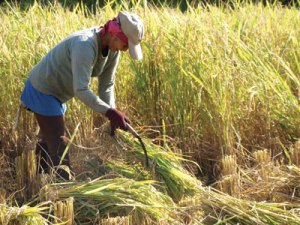
Located in the Pang Ma Pha highlands, the area is famous for cave exploration. Just 10 years ago Muang Pam, situated 6 km from Tham Lod (Lod Cave), was one of the key tourist attractions after a tour operator set up an elephant camp offering rides and trekking as side trips from the caves.
Tourism in Muang Pam dropped dramatically after the elephant camp closed, but despite the loss in revenue, the bright side was that the environment was not seriously damaged by heavy tourism. Who knows if tourism had continued, the condition of the forest and the caves might have declined much further. Tourism hibernated for a decade, but is now waking up as villagers adopt a more sustainable direction that does not rely on outside tour operators.
The pilot tour programme in Muang Pam is three days/two nights. There is not much to do on the first day other than to get there and enjoy a very local style dinner. The highlight is the Karen open hearted greetings. They make you feel welcome from the start.
The simple local meal is delicious served in the home’s common room where after dinner we relax drinking tea and chatting by the fireplace learning about Karen culture and life style.
For Thais, communication is not much of a problem. Most of the villagers speak Thai with the exception of the very old folk, who can understand, but reply in their northern dialect.
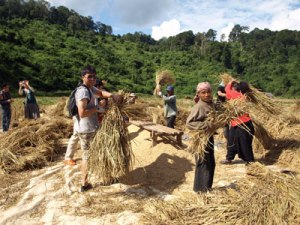 I love the common room, a multi-purpose area that includes kitchen, living room and bed room. Activities happen around the fireplace. The fire is kept lit almost all day. Traditional houses are giving way to more modern and stronger building methods. Timber replaces bamboo to offer more protection from the wind.
I love the common room, a multi-purpose area that includes kitchen, living room and bed room. Activities happen around the fireplace. The fire is kept lit almost all day. Traditional houses are giving way to more modern and stronger building methods. Timber replaces bamboo to offer more protection from the wind.
The morning is refreshing with views of the mountains covered in mist and beams of warm sunlight breaking through clouds. It is a good sign for trekkers.
Originally Muang Pam’s caves were on the tour agenda, as well, but eventually deleted due to their fragile environment. Stalagmite and stalactites are alive and growing. Our skin oil can alter the surface where the mineral water clings, affecting the growth of the formation. Oils and dirt from human contact can also stain the formation and change its color permanently. Cave ecology has to be considered, when developing tourism in these sensitive areas.
 A management plan should come first before the tourists can visit and it starts with surveys that take into account local conditions. Actually, there have been some tourists visiting the caves; but for sustainability, the villagers need to make the decision on the numbers, opening hours and the requirements of village guides.
A management plan should come first before the tourists can visit and it starts with surveys that take into account local conditions. Actually, there have been some tourists visiting the caves; but for sustainability, the villagers need to make the decision on the numbers, opening hours and the requirements of village guides.
Before entering the community’s protected forest, we walk through paddy fields to see people harvesting golden brown rice. From the harvesting field, we also get to see people threshing rice and having fun too as this is a community activity. It is the wrong time of the year to be able to admire rice terraces as the rice has been harvested.
We enter the forest. The trail is not difficult; just mild uphill or downhill gradients with some streams to cross. Along the way there are herds of cattle free range during the day snacking on grass. Buffaloes enjoy a day spa in the cool stream. On the way we learn more about herbal medicines derived from the forest.
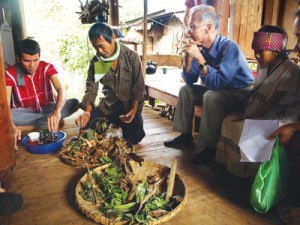 Around 10 years ago, villagers initiated conservation of this 2,000 rai (970 acres) forest reserve that is limited to forest products and herb collection, small animal hunting. There were debates among villagers. Outsiders also intruded on the forest, but at the end of the day efforts began bear fruit as a fertile forest gave a source of sustainable living for the villagers.
Around 10 years ago, villagers initiated conservation of this 2,000 rai (970 acres) forest reserve that is limited to forest products and herb collection, small animal hunting. There were debates among villagers. Outsiders also intruded on the forest, but at the end of the day efforts began bear fruit as a fertile forest gave a source of sustainable living for the villagers.
Besides the forest, they have conserved fish designating an area upstream from a check dam where fishing is prohibited. The fish are mainly Mahseer Barb that are commonly seen in waterfalls and ponds around the country.
The lunch is prepared by each host family and eaten by a stream. The utensils made from bamboo are very interesting: a long tray made from halved bamboo that can fit three dishes; a dish from one big section of bamboo; glasses from smaller bamboo and the pot to boil water made from bamboo that has holes on the top to release vapours and a big hole in the front to pour the water.
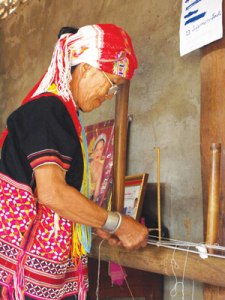 Here in Muang Pam there is also an old weaver who sells hand-woven bamboo utensils such as baskets, fishing gear, mats, cases. He is one of just a few people who are capable of producing this functional art. It is also a challenge to think of new designs to suit the needs of modern society.
Here in Muang Pam there is also an old weaver who sells hand-woven bamboo utensils such as baskets, fishing gear, mats, cases. He is one of just a few people who are capable of producing this functional art. It is also a challenge to think of new designs to suit the needs of modern society.
Herbal medicine, too, is in danger. It is amazing to see the variety of herbs and plants that can be beneficial to health. The knowledge is handed down from father to son, but the new generation does not pay much attention to ancient wisdom. When they get sick, people turn to modern doctors and pills which is a fast track cure; unlike the herbs that take time, but are often safer and cheaper.
But the production of fabrics and clothes continues to prosper. Even today women have to learn the process of weaving including embroidering starting from when they around 10 years old or even younger. Women usually wear traditional clothes – blouses and sarong. During this tour we learn how to dye fabrics with natural colours and are introduced to the weaving process, but there is a lot more we can learn about clothing as it associates closely with the culture. It can be added to the programme in the future.
Test Drive
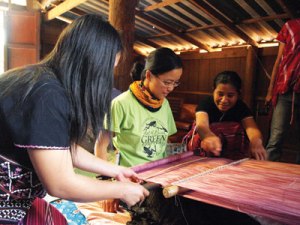 The pilot guests are a mix of Thai and international tourists. The Thailand residents visiting the village include local business (tour, hotels and restaurant, local government tourism offices, representative from local tourism association and academics.
The pilot guests are a mix of Thai and international tourists. The Thailand residents visiting the village include local business (tour, hotels and restaurant, local government tourism offices, representative from local tourism association and academics.
This gives the project a variety of feedback comments from different perspectives. UNDP will wrap up the project mid-next year. Local entrepreneurs like hotels and restaurants will play a part in working with the project to distribute the local products to visitors at their venues.

Both Muang Pon and Muang Pam, gain “Pass” approval from their guests. While there are glitches to be ironed out, they are actually excellent in terms of potential in presenting valuable cultural and natural assets.
Muang Pon is highly distinctive in Tai Yai traditions that are still healthy in the community; whereas, Muang Pam’s strength is built around life in the highlands, the relationship between humans and nature and the need to balance conservation and use.
Issues being raised in both communities are similar in some aspects . They include:
• How to present information in a comprehensive and interesting way. With so much to tell and the villagers have extensive knowledge, it takes a guide with a passion for sustainable tourism to pass on the knowledge to visitors. This will need time and training to brush up guiding skill. Examples of various crafts would also help when explaining about the subject. The villagers need to cross check their stories and details so they say the same things and are singing off the same sheet.
• More interaction with the locals: It does not have to be activities as a group, but it could be spending time with family members and picking up valuable cultural insights.
• Language barrier: For Thais, the language problem is less as most people in both communities can speak Thai, except for a few grandmas and grandpas. In case of foreign visitors, they will need a very experienced guide. Publishing a handbook of vocabruary and phrases in local language, Thai and English would much help facilitate communications.
• Itineraries should be flexible to adjust to different agricultural activities and the event calendar.
• More interesting activities that exist in the community can be added such as herbal medicine and massage in Muang Pon and explanations about Karen houses and the rotational farming system in Muang Pam
• A map of the village would also help visitors to explore on their own.
In Muang Pon because of its close proximity to Mae Hong Son and the district town, tourists may not need to stay in the village. The community can also design a day programme to serve this group.
The accommodation is not an issue in Muang Pon. Guests sleep on a mattress with mosquito nets and electric fan. Some houses do not have toilets in the house, but the path to the outside toilet is well lit. The village is very close to town so the basic facilities are up to standard.

In contrast, at Muang Pam the toilet and bathroom is an important issue for foreigners especially because it is some distance from the houses and the path is slippery. There is no light so it is difficult during the night. The Thai style squat toilet is another comfort challenge for foreigners who like to sit on a throne style toilet in comfort and read the newspaper. There are no showers either, just a bowl to scoop water out of a large water container. An orientation on what they should expect would help reduce culture shock.
All in all, Muang Pon and Muang Pam have the right ingredients, the fundamental element to cook a delicious tour programmes per say; recommendations from their guests will guide them to adapt and make changes so feedback is essential.
At the same time there are concerns about how to sustain traditions and good practices. Hopefully, established community-based tourism projects like these two examples will help others to check out the benefits and even more encourage others to conserve precious assets, while building prosperity and improving quality of life.
From : TTRWEEKLY